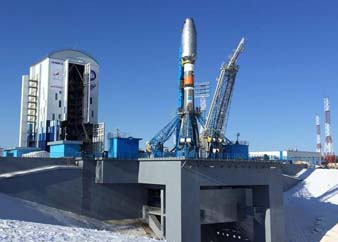
This morning it has taken place the launching, from the new Russian cosmodrome Vostochny, of the space telescope Ultra-Fast Flash Observatory (UFFO), that will study the gamma-ray outburst, very brief phenomena that consist of the most extreme explosions of the Universe. They are the kings of the Violent Universe of High-Energy. The Universitat de València has develop the software, the coded-aperture mask and the mechanics of the space telescope. The works have been carried out at the Image Processing Laboratory (LPI-Scientific Park) and at the company Trinos Vacuum Projects, in Paterna.
UFFO has been developed by an international collaboration lead by Korea, and of which there also take part Russia, Spain, Taiwan and Denmark. The Spanish collaboration has been managed from the Instituto de Astrofísica de Andalucía (IAA) (Astrophysics Institute of Andalusia) and from the Universitat de València that has developed the hardware flight of UBAT: Coded-aperture mask (optical system), complete Mechanic Structures, Trigger Algorithms and the software to take pictures in a time below 1 second written in high speed FPGAs.
The space telescope is part of the cargo of the Lomonosov satellite, which launching is the first realised from the new Vostochny cosmodrome, near the Kamchatka peninsula.
UFFO/Lomonosov is a tracking space telescope that will detect X-rays and track UV/optical lights emitting from very early moment of Gamma-ray Bursts (GRBs) which opens a new horizon in studying and understanding of the extreme universe and early universe.
The UFFO-pathfinder will look into the deep space at the altitude of 490 km with the desired mission lifetime of at least 3 years. After the 3-month period of initial testing operation and calibration. ‘It has been a great effort which needed the collaboration of lots of institutions to complete it on the half of the time (5 years) which had been needed by the space agencies with common development periods of 10 years’, said the professor Víctor Reglero, researcher of the Universitat de València.
‘The coordination with Soomin Jeong (manager of the project), who has been with us the three last years in Granada, has been important and now is the moment of harvest fruits: to capture that first light of the GRBs is a desire for all the researchers of this field and it will be a reality’, points the professor Alberto J. Castro-Tirado, researcher of the Institute of Astrophysics of Andalucía (IAA-CSIC) which participates in the project and will lead the science of UFFO on the parts of Spain in collaboration with the Universitat de València.
The data-processing of High-Energy in the aspect of localization of the sources will be a continuous work for the Image Processing Laboratory of the UV in co-operation with the IAA.
More information:
Lomonosov webpage:http://lomonosov.sinp.msu.ru/en/
Vostochny webpage:http://vostokdrom.ru/
Roscosmos TV online:
http://www.tvroscosmos.ru/5129/ andhttp://www.tvroscosmos.ru/5323/
Last update: 28 de april de 2016 12:47.
News release



















